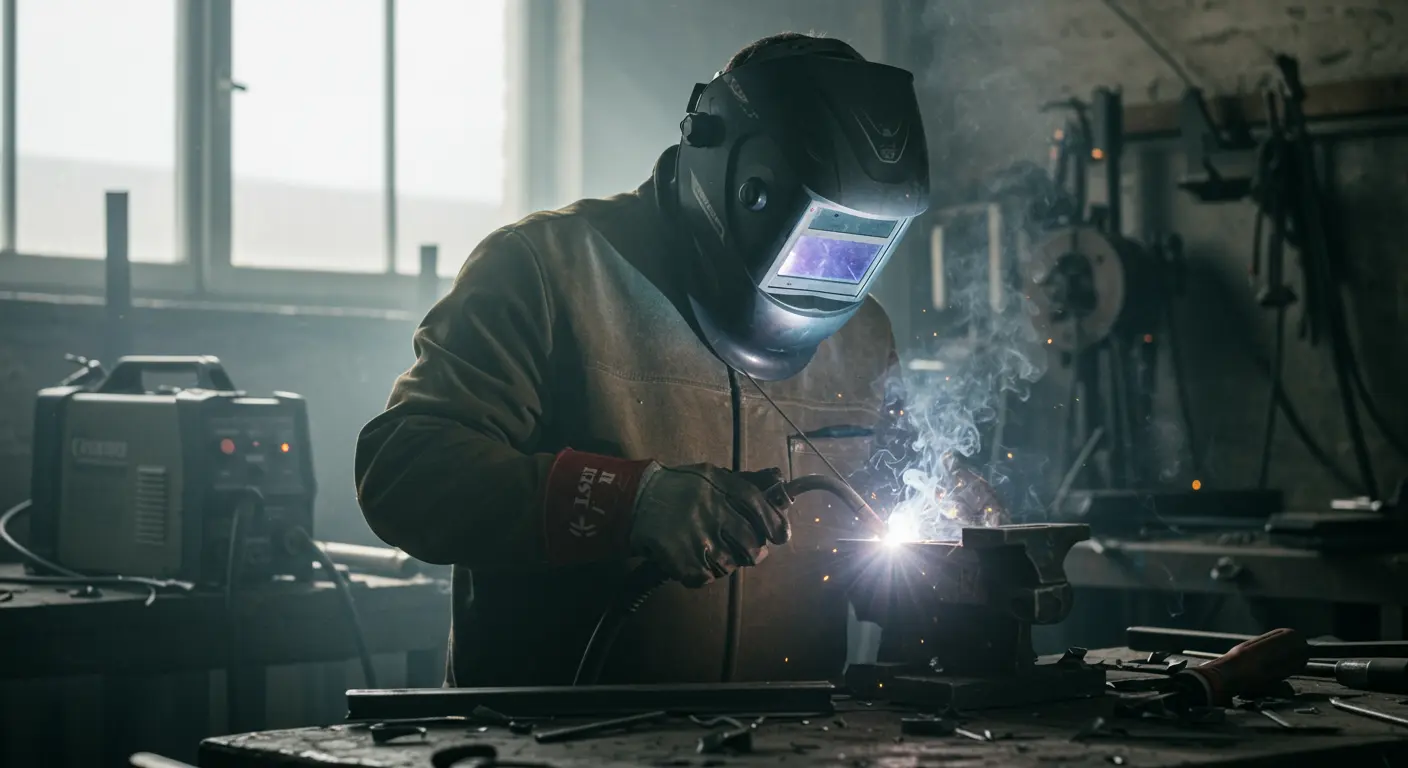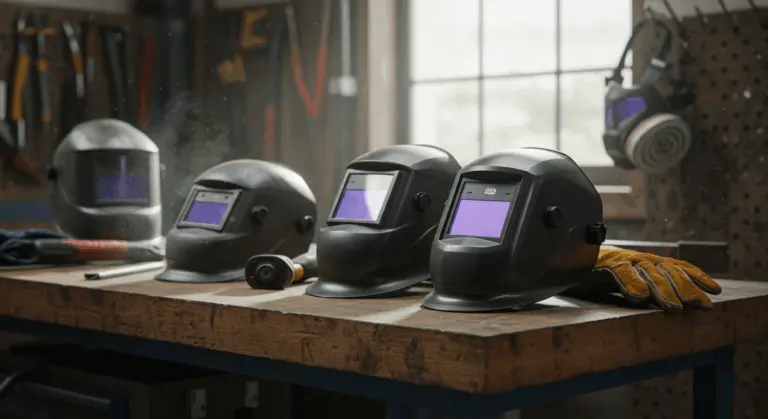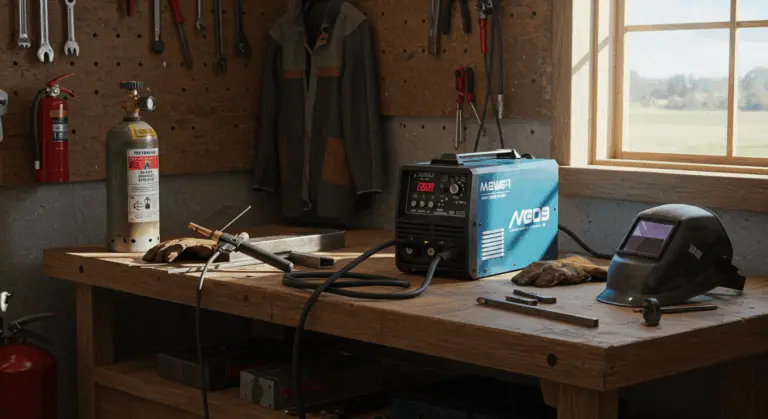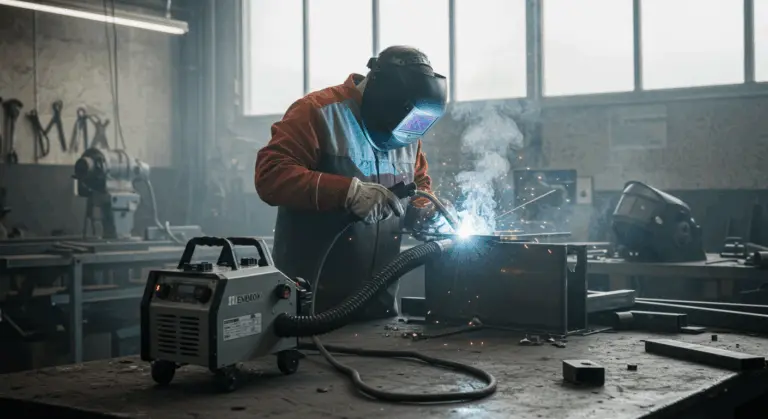What is Arc Flash in Welding?
Arc flash in welding represents an intense burst of ultraviolet (UV) radiation produced during the welding process. This brilliant, searing flash can severely burn the cornea—the eye’s protective outer layer—resulting in a painful condition called ‘welder’s flash’ or ‘arc eye’ when proper protective equipment isn’t utilized.
Arc welding uses an electric arc to generate intense heat, melting and fusing metals into unified joints. This electric arc forms between a consumable or non-consumable electrode and the base material, utilizing either direct current (DC) or alternating current (AC). The temperatures achieved are staggering—reaching up to 35,000°F (19,426°C)—rendering this process both highly effective and inherently hazardous.
The concentrated heat from the electric arc melts metal at the welding point, allowing the welder to fuse this molten material and shape it into the desired weld. While this process is excellent for joining metals, its intense light and UV radiation create significant health risks for eyes and skin without proper safety protocols.
Understanding Welder’s Flash
Causes of Arc Flash During Welding
The main cause is Intense UV radiation produced by the electric arc. Unlike electrical arc flash in power systems—which concerns fault energy—welding arc flash hazards center primarily on UV radiation exposure.
Several factors contribute to arc flash incidents:
-
Direct Exposure: The most common cause is viewing the arc without proper eye protection.
-
Improper Equipment Use: Incorrect settings or malfunctioning gear can intensify UV radiation.
-
Environmental Factors: Reflective surfaces like aluminum can bounce UV rays, while poor ventilation concentrates them in enclosed spaces.
Human error is the main cause of arc flash injuries. Common mistakes include:
-
Failure to Use PPE: Not wearing a welding helmet or using one with an inadequate shade number.
-
Premature Removal of Protection: Removing a helmet or glasses too soon after the weld is complete.
-
Proximity and Barriers: Working too close to other welders without using protective screens.
-
Complacency: Bypassing safety protocols for seemingly quick tasks—a decision that greatly increases risk.
Role of Welding Equipment
Welding equipment provides essential protection against arc flash injuries. Welding helmets—particularly those equipped with auto-darkening lenses—are the main line of defense, automatically blocking intense UV radiation while preserving clear visibility of the work area.
Auto-darkening helmets are a major safety advancement. Unlike fixed-shade helmets, they eliminate the need to flip the helmet up and down, reducing exposure risk. These helmets feature adjustable shade settings (typically #9 to #13), allowing exact protection adjustment for specific welding processes and amperage requirements.
Beyond helmets, comprehensive protection requires other essential gear and regular maintenance:
-
Protective Clothing: Flame-resistant clothing shields the skin, and specialized leather gloves protect the hands and forearms.
-
Ventilation Systems: Proper ventilation removes harmful fumes generated during welding.
-
Regular Inspection: Damaged lenses, cracked helmets, or worn-out clothing compromise safety and must be replaced promptly.
Symptoms and Effects of Arc Flash
Symptom severity depends on both the arc’s intensity and exposure duration. Mild cases may trigger minor discomfort, while severe exposure can cause intense pain and temporary blindness lasting hours or even days. Most concerning is that Repeated incidents can lead to permanent vision damage.
Arc flash impacts the eyes through a mechanism remarkably similar to sunburn affecting the cornea and conjunctiva. The UV radiation essentially burns these tissues, causing inflammation and cellular damage. This tissue damage activates the body’s defensive mechanisms—heightened tear production, swelling, and pain signals—generating the telltale symptoms of arc eye.
Beyond immediate vision effects, arc flash can inflict skin damage resembling severe sunburn on exposed areas like the face, neck, and arms. This dual threat to both eyes and skin shows why comprehensive, full-body protection is absolutely necessary.
Immediate and Long-term Effects
Immediate symptoms typically emerge 3–12 hours post-exposure—a treacherous delay that frequently surprises welders. These symptoms, which often worsen at night, include:
-
A gritty sensation, as if sand is in the eyes.
-
Intense pain, redness, and excessive tearing.
-
Swollen eyelids and extreme sensitivity to light (photophobia).
Though most arc eye cases resolve within 24–48 hours, repeated or severe exposures can cause serious long-term consequences:
-
Cataracts: Studies show career welders often develop them at an earlier age.
-
Pterygial: Abnormal tissue growth on the eye’s surface.
-
Macular Degeneration: Damage to the part of the retina responsible for sharp, central vision.
-
Permanent changes to color perception.
Long-term UV exposure also increases skin cancer risk on exposed areas like the face and neck. Given the cumulative damage to both eyes and skin, consistent protection and regular eye examinations are essential for a welder’s long-term health and permanent vision preservation.
Prevention Strategies for Arc Flash
Strategic welding techniques can significantly reduce UV radiation exposure. Effective strategies include:
-
Gradual Arc Termination: Avoid abruptly cutting the arc to reduce the final flash intensity.
-
Consistent Filler Material: Maintain a steady supply of filler material to ensure a stable arc.
-
Backfilling: Gradually reduce welding current while adding filler material at the end of a weld to prevent intense flashes.
Technical prevention methods encompass using run-off tabs to extinguish the arc away from the main joint and grinding stop craters for seamless transitions. Automated systems can also be programmed with current reduction sequences to minimize flash intensity.
Ultimately, the most fundamental prevention strategy is consistent use of proper PPE usage. Every welding task—regardless of duration—demands appropriate eye protection. This is because Even momentary exposure can cause painful injury.
Best Practices for Welding Safety
Establishing a secure work environment is the basis for welding safety:
-
Ventilation: Always weld in a well-ventilated area to disperse harmful fumes.
-
Fire Safety: Keep the workspace clear of combustible materials by at least 35 feet.
-
Electrical Safety: Avoid welding in wet or damp conditions to prevent electric shock.
-
Ergonomics: Ensure your work position is stable and comfortable to maintain control.
Personal protective equipment (PPE) is the foundation of welding safety. Essential gear includes:
-
Welding Helmet: With an appropriate shade rating (typically #10-#13).
-
Fire-Resistant Clothing: To protect the skin.
-
Leather Gloves: Heavy-duty gloves to cover hands and forearms.
-
Safety Boots: Preferably with metatarsal guards.
-
Respiratory Protection: When working with hazardous materials or in confined spaces.
-
Safety Glasses: Worn under the helmet for protection when the shield is up.
Cultivating safe work habits is just as important as utilizing proper equipment:
-
Inspect Equipment: Before use, check for damage to cords, connections, and components.
-
Secure Gas Cylinders: Ensure they are upright and secured to prevent tipping.
-
Never Weld on Unsafe Containers: Do not weld on containers that held combustibles unless professionally cleaned and certified.
-
Maintain Awareness: Be mindful of other workers who could be exposed to your arc.
-
Follow Shutdown Procedures: Turn off all equipment and never leave hot materials unattended.
Treatment Options for Arc Eye
Most arc eye cases resolve within 24–48 hours and respond well to straightforward home remedies:
-
Cool Compresses: Apply to closed eyes for 15–20 minutes to reduce swelling and pain.
-
Pain Relievers: Use over-the-counter options like ibuprofen or acetaminophen.
-
Artificial Tears: Keep eyes lubricated and soothe irritation.
-
Rest in a Dark Room: Avoid bright light and screens to minimize discomfort.
For severe cases, an ophthalmologist may prescribe treatments such as:
-
Antibiotic eye drops to prevent infection.
-
Specialized lubricating drops to promote healing.
-
Prescription pain medication for severe discomfort.
-
Cycloplegic drops to relax eye muscles and reduce pain.
-
Bandage contact lenses to protect a damaged cornea.
Prompt treatment is important—ignoring symptoms can lead to complications like infection or further damage. Since each incident increases long-term risk, future prevention is as important as immediate treatment.
When to See an Ophthalmologist
Though mild cases typically resolve at home, seek immediate ophthalmological attention for these warning signs:
-
Severe pain not relieved by over-the-counter medication.
-
Vision changes that persist for more than 24 hours.
-
Yellow or green eye discharge, which may indicate infection.
-
Visible damage to the eye’s surface.
You should also see a doctor if symptoms do not improve within 48 hours or if they worsen. After multiple episodes of arc eye, a comprehensive exam is recommended to check for cumulative damage.
Professional welders should schedule regular eye examinations to detect early signs of chronic UV damage—such as cataracts—before they compromise vision. Your eyesight cannot be replaced. When in doubt, always seek professional evaluation.





